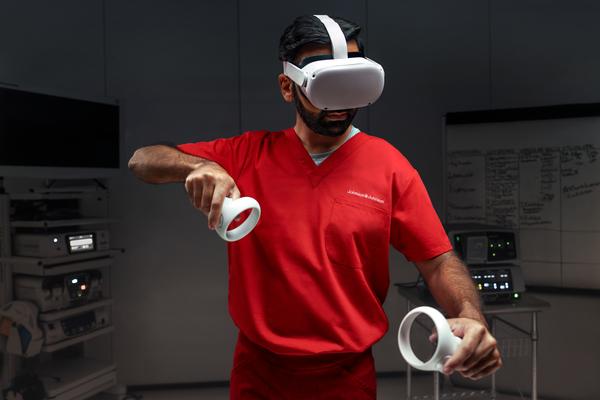Hospitals generate 50 petabytes of data annually, according to the World Economic Forum. That's more than twice the data the Library of Congress oversees. But how can this vast amount of information be managed and put to good use?
Advances in computing and artificial intelligence (AI) have made it possible to process large volumes of images and other multimodal datasets and find deep insights that can help alleviate some of the most pressing challenges in healthcare, such as a global shortage of experienced surgeons. Insights from data can also enable personalized healthcare, training and coaching for surgeons, as well as optimize hospital operations and enable proactive decision-making based on analytics.
In particular, procedural data, which includes information about the processes, techniques and devices involved in medical procedures, holds crucial knowledge for surgeons and patients alike. When all this data is accessed and analyzed, it can significantly improve patient care, operational efficiency and overall hospital performance.
Results from a new survey show strong support for innovations in data and technology, including AI, among nearly 1,000 healthcare professionals (HCPs) and more than 11,000 adults across 11 countries.
And yet, data collection is complex because of several factors. These include a lack of standardization and centralization of data, difficulty obtaining informed consent for retrospective data collection, cybersecurity concerns, privacy requirements, and regulatory compliance and regional differences, such as laws that prevent moving or processing data in other countries.
“Right now, hospitals often see the task of securely storing and managing data as a challenge to overcome,” says Shan Jegatheeswaran, Vice President, Global Head of MedTech Digital, Johnson & Johnson. “But an important step in dealing with that challenge is to also recognize data as an opportunity and to think critically about the best ways to seize that opportunity.”
And this is where medical technology companies play a crucial role: In addition to their expertise in areas like data analytics, AI and machine learning, medtech companies—including Johnson & Johnson MedTech—are making progress on data initiatives and strategic collaborations, through which the surgical community is working to overcome several industry-wide challenges to unlock data's full potential.
And there's a huge industry wide appetite for that: Results from a new survey show strong support for innovations in data and technology, including AI, among nearly 1,000 healthcare professionals (HCPs) and over 11,000 adults across 11 countries. For example, 72% of HCPs believe these advancements will significantly reduce provider burnout, a critical issue in healthcare today, and over 75% of adults globally are willing to share personal health data for personalized treatment plans, reflecting a high level of public trust in data-driven healthcare solutions.
Read on to learn more about the promise that data holds for surgery.
Facilitating info sharing and collaboration
One of the challenges hospitals face in harnessing the power of procedural data is its fragmentation across different systems and departments, making it difficult to integrate and analyze seamlessly—a significant roadblock because a comprehensive dataset is necessary for research, benchmarking and quality improvement initiatives.
To wit: 80% of the data that hospitals generate each year is unstructured, and 97% goes unused.
“The OR today is predominately a physical space,” says Jegatheeswaran. “The ‘what happens in the OR stays in the OR’ line of thought isn’t going to work in the future as we think about connected devices. There has to be a central brain in the OR to make sure all the datasets are speaking to each other.”

An open and secure system can integrate electronic medical records, data from medical devices and other relevant data sources to streamline surgical planning, performance and follow-up to improve efficiency and training.
This type of data synthesis will allow surgeons, hospitals and their administration to better plan, perform and follow up on surgeries, explains Nikhil Gulati, Ph.D., Global Head of Engineering and AI, Johnson & Johnson MedTech, Digital. "It can also improve patient outcomes and help in running operating rooms in a more efficient manner."
Data can also give surgeons information about a patient's anatomy that isn’t necessarily clinically available. For instance, in orthopaedics, Johnson & Johnson has supported research into computational models that could, for example, guide surgeons to accurately predict tendon tensions, which is especially helpful in the case of knee implant procedures. Surgeons often rely on their experience to make surgical adjustments, and the type of data that computational models may provide can take out the guesswork, enabling them to make precise cuts for balanced tension.
Surgeons can use AI-powered software to provide patient-matched recommendations based on procedural data and specific variables, such as comorbidities and anatomies. This capability enables personalized treatment plans tailored to each patient's unique needs, which could improve the likelihood of positive outcomes.
The company is also partnering on AI-powered pre-operative planning software for bunion surgeries: The platform analyzes patient imaging and assists in the selection of the most appropriate instrument based on a patient's imaging, helping tailor their treatment plan.
Polyphonic—Johnson & Johnson MedTech’s digital ecosystem for surgery, which is agnostic to data source and is currently in beta testing in select hospitals—features applications for surgical video, telepresence and case planning to help surgeons and surgical teams increase collaboration and OR workflow efficiency within an integrated, user-focused solution that aims to deliver actionable and objective insights.
Democratization of clinical care to improve patient outcomes
By analyzing surgical data, hospitals can standardize procedures to help ensure all patients receive the highest standard of care—no matter where they are located.
One example: Using data from past procedures, hospitals can power risk algorithms to identify patterns such as common errors or complications associated with specific techniques or devices. This information can then be used to develop protocols and training programs that mitigate these risks, enhancing patient safety. This is especially important for patients in underserved areas, such as rural locations with fewer resources and surgeons with specialized expertise.
Data can also help close the care gap by enabling a senior surgeon to guide and advise via telepresence or enabling technology to help course-correct during a procedure.
As Gulati puts it: "Surgeons are extremely competent, but there are scenarios that happen during surgery—depending on the patient’s anatomy or condition—where algorithms and computer vision can guide and provide real-time analysis that allows them to address unforeseen complications.”
Supporting continuous learning and innovation
As hospitals evolve and adapt to new technologies, techniques and best practices, AI can leverage data from medical devices to create educational tools to help surgeons master these new modalities.
"Today, we use several simulation tools for training, but in the future, we might use AI-assisted training for new surgeons to assess performance and efficiency of different procedures," says Gulati.
Data can help surgeons strive for excellence by providing metrics such as how long surgery takes, how soon patients are discharged and overall results. With this information, surgeons can see how they compare to their peers who are performing the same operations.
Surgeons can use data to continuously improve their techniques and outcomes. For example, the Johnson & Johnson Institute—which provides virtual training as well as 24 physical centers on five continents—offers educational options that include guiding surgeons through procedures step-by-step and providing feedback.

A data-driven future
Data is a disruptive technology, and adopting ways to harness it doesn't happen overnight; it takes collaboration, communication and interest to build an ecosystem and drive adoption.
Patient privacy, cybersecurity and regulatory compliance will continue to be essential factors in how the medical community utilizes data. But as data collection becomes more streamlined, the industry will be able to create incredible opportunities for improving clinical outcomes.
“It is easy to understand why data can be seen as a burden in some situations. It takes a lot of care and cost to store it securely. It can be problematic to share it, especially internationally, from a regulatory standpoint,” says Jegatheeswaran. “But we should never lose sight of the fact that freeing data is also the key to making healthcare better.”
© Johnson & Johnson and its affiliates 2025. US_ETH_RADS_393599
.jpg&w=3840&q=75)